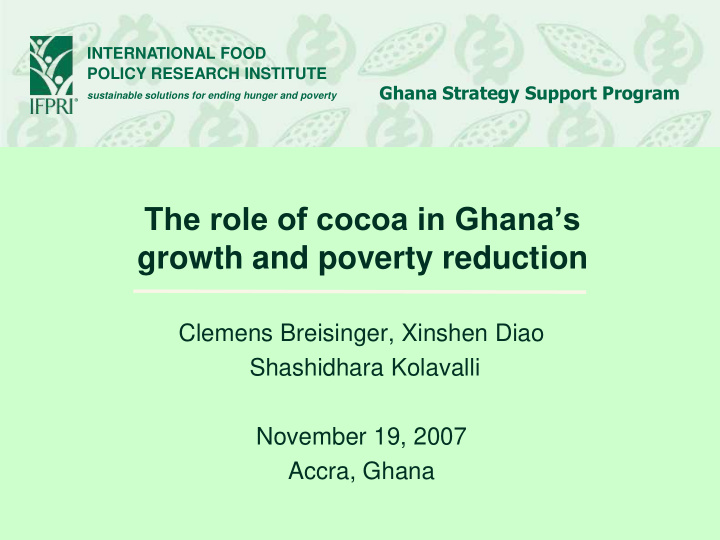



INTERNATIONAL FOOD POLICY RESEARCH INSTITUTE Ghana Strategy Support Program sustainable solutions for ending hunger and poverty The role of cocoa in Ghana’s growth and poverty reduction Clemens Breisinger, Xinshen Diao Shashidhara Kolavalli November 19, 2007 Accra, Ghana
Outline • Cocoa in recent economy-wide growth • Cocoa in poverty reduction • Cocoa for reaching MIC status • Future challenges for the cocoa sector Ghana Strategy Support Program Page 2 INTERNATIONAL FOOD POLICY RESEARCH INSTITUTE
The role of cocoa in economy-wide growth • Production increased from 395,000 MT in 2000 to 740,000 MT in 2005 and • Cocoa producer price increased • Share of cocoa in GDP rose from 4.9% in 2000-2004 to 8.1% in 2005/2006 • Cocoa accounted for 22.6% of AgGDP (with forestry and fishery) or 28.5 % (without forestry and fishery) • Cocoa contributed 28% to agric growth (excluding forestry and fishery) • Cocoa exports constituted 28% of foreign exchange earnings, 57% of overall agricultural exports, and 87% if forestry and fishery are excluded Ghana Strategy Support Program Page 3 INTERNATIONAL FOOD POLICY RESEARCH INSTITUTE
Trends of major cocoa indicators 300 Production Area Yield 250 Index (2000=100) Real producer price FOB price 200 150 100 50 2000 2001 2002 2003 2004 2005 2006 Ghana Strategy Support Program Page 4 INTERNATIONAL FOOD POLICY RESEARCH INSTITUTE
Economy-wide linkage effects of cocoa • Strong cross sector linkages through • Cocoa processing (milling and butter) • Food industry (beverages, bakery, etc) • Government revenue to support other sectors • Processed cocoa exports increased from 83.6 mil. US$ in 2004 to 152.9 mil. in 2006 • 5% of government revenue coming from cocoa export tax in 2005 • Still, only 8-15% processed domestically • Mainly low value added Ghana Strategy Support Program Page 5 INTERNATIONAL FOOD POLICY RESEARCH INSTITUTE
The role of cocoa in past poverty reduction 1991/92 1998/99 2005/06 Total population Poverty rate 51.7 39.5 28.5 Poverty gap 18.5 13.9 9.6 Cocoa producers Poverty rate 60.1 36.7 23.9 Poverty gap 23.3 9.4 6.0 Source: Wodon and Coloumbe, 2007 Ghana Strategy Support Program Page 6 INTERNATIONAL FOOD POLICY RESEARCH INSTITUTE
Projected future growth and poverty reduction in Ghana – the model results poverty rate (%) p.c. income (US$) 30.0 8% average annual 950 growth necessary 26.0 850 22.0 750 MIC Base 18.0 650 Base MIC 14.0 550 10.0 450 2005 2007 2009 2011 2013 2015 Ghana Strategy Support Program Page 7 Source: Breisinger et al. 2007 INTERNATIONAL FOOD POLICY RESEARCH INSTITUTE
The role of cocoa in reaching MIC • Agriculture will have to play a major role in reaching MIC status • Cocoa continues to grow (at 6.4% annually), but share in agricultural GDP falls slightly (to 15%) • Cocoa remains the most important export agricultural commodity (60% of agric. exports by 2015) Ghana Strategy Support Program Page 8 INTERNATIONAL FOOD POLICY RESEARCH INSTITUTE
The role of cocoa in poverty reduction is likely to decrease Poor rural houseshold distribution by Poor rural cocoa growing houseshold distribution by pc income quintile pc income quintile (19% of rural households growing 40 cocoa) 35 1st qunitle 3.0 1st qunitle 2nd quntile 30 2nd quntile 2.5 25 2.0 20 1.5 15 10 1.0 5 0.5 0 0.0 Coast S. Savannah N. Savannah Forest Total t t h l s a s a a e t o n o r T o n C F a v a S . S Ghana Strategy Support Program Source: Authors’ calculations based on GLSS5 Page 9 INTERNATIONAL FOOD POLICY RESEARCH INSTITUTE
Poverty will concentrate in the North among non-cocoa farmers Base 2015: 14.0% Current poverty rate 28.5% South North Poverty rate 45.1% North South MIC 2015: 9.5% South Poverty \ North rate Poverty 62.7% rate Ghana Strategy Support Program 35.1% Page 10 INTERNATIONAL FOOD POLICY RESEARCH INSTITUTE
Future challenges for the cocoa sector • Productivity growth has to become increasingly important • Supply-side competition is likely to increase (cocoa as a strategic or targeted commodity in other big cocoa export countries, e.g., Indonesia, Cote d’Ivore, Nigeria) • World cocoa price is likely to decline • Barriers for growth in cocoa processing exports remain (high tariffs in EU and US) • Increased import competition of food sector (using cocoa as an input) in domestic market Ghana Strategy Support Program Page 11 INTERNATIONAL FOOD POLICY RESEARCH INSTITUTE
INTERNATIONAL FOOD POLICY RESEARCH INSTITUTE Ghana Strategy Support Program sustainable solutions for ending hunger and poverty Thank you!
Regional concentration of cocoa production 2001/02 2002/2003 2003/04 metric tons metric tons metric tons 1,021 - 5,000 913 - 5,000 1909 - 5000 5,001 - 25,000 5,001 - 25,000 5001 - 25000 25,001 - 50,000 25,001 - 50,000 25001 - 50000 50,001 - 100,000 50,001 - 100,000 50001 - 100000 Ghana Strategy Support Program Page 13 100,001 - 181,865 100,001 - 276,587 100001 - 419650 INTERNATIONAL FOOD POLICY RESEARCH INSTITUTE no production no production no production
Recommend
More recommend